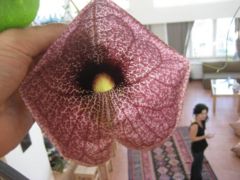Aristolochia gigantea: Difference between revisions
No edit summary |
No edit summary |
||
| Line 1: | Line 1: | ||
{{SPlantbox | |||
| | |familia=Aristolochiaceae | ||
| | |genus=Aristolochia | ||
| | |species=gigantea | ||
| | |common_name=Giant Dutchman's Pipe | ||
| | |habit=vine-climber | ||
| | |Min ht metric=cm | ||
| origin = Brazil, Costa Rica, Panama | |Max ht box=10 | ||
| exposure = | |Max ht metric=m | ||
| features = | |Max wd box=10 | ||
| | |Max wd metric=m | ||
| | |origin=Brazil, Costa Rica, Panama | ||
| | |lifespan=perennial | ||
| image = Aristolochia_gigantea-giant_dutchmans_pipe.jpg | |exposure=sun | ||
| image_width = | |water=regular | ||
| image_caption = | |features=flowers | ||
|Min Temp Num=50 | |||
|Temp Metric=°F | |||
|min_zone=10 | |||
|max_zone=11 | |||
|image=Aristolochia_gigantea-giant_dutchmans_pipe.jpg | |||
|image_width=240 | |||
|image_caption=Aristolochia gigantea grown indoors | |||
}} | }} | ||
'''''Aristolochia gigantea''''' ('''Brazilian Dutchman's Pipe''', '''Pelican Flower'''; [[syn.]] ''Aristolochia sylvicola'' Standl.) is an evergreen, fast growing vine, native to [[Brazil]]. | '''''Aristolochia gigantea''''' ('''Brazilian Dutchman's Pipe''', '''Pelican Flower'''; [[syn.]] ''Aristolochia sylvicola'' Standl.) is an evergreen, fast growing vine, native to [[Brazil]]. | ||
==Cultivation== | ==Cultivation== | ||
Prefers fertile soil with good drainage{{AHS}}. Grow in sun or part-sun{{AHS}}. Provide strong support, and you may prune after flowering{{AHS}}. | |||
===Propagation=== | ===Propagation=== | ||
Cuttings for true clones. | Cuttings for true clones. Seeds can be sown at 70-75F (21-24C) upon ripening, or in spring. | ||
=== Pests and Diseases === | === Pests and Diseases === | ||
Some problems you may encounter include ''Cercospora'' leaf spot, gray mold, [[Southern blight]], ''Pythium'' root rot{{AHS}}. | |||
==Varieties== | ==Varieties== | ||
| Line 39: | Line 39: | ||
Aristolochia gigantea 'Brasiliensis' - Spectacular flowers, up to 1 foot long (30 cm), this species from Brazil is huge. Each flower displays an intricate pattern of white and mottled reddish-brown. Draw close to it and smell its lemon scent. With a little training, it can be contained to a limited space, such as a hanging basket. | Aristolochia gigantea 'Brasiliensis' - Spectacular flowers, up to 1 foot long (30 cm), this species from Brazil is huge. Each flower displays an intricate pattern of white and mottled reddish-brown. Draw close to it and smell its lemon scent. With a little training, it can be contained to a limited space, such as a hanging basket. | ||
__NOTOC__ | |||
Revision as of 04:16, 17 October 2009
| Aristolochia gigantea subsp. var. | Giant Dutchman's Pipe | |||||||||||||||||||||||||||||||||||||||||||||||||||||||
|---|---|---|---|---|---|---|---|---|---|---|---|---|---|---|---|---|---|---|---|---|---|---|---|---|---|---|---|---|---|---|---|---|---|---|---|---|---|---|---|---|---|---|---|---|---|---|---|---|---|---|---|---|---|---|---|---|

|
|
| ||||||||||||||||||||||||||||||||||||||||||||||||||||||
| ||||||||||||||||||||||||||||||||||||||||||||||||||||||||
Aristolochia gigantea (Brazilian Dutchman's Pipe, Pelican Flower; syn. Aristolochia sylvicola Standl.) is an evergreen, fast growing vine, native to Brazil.
Cultivation
Prefers fertile soil with good drainageAH. Grow in sun or part-sunAH. Provide strong support, and you may prune after floweringAH.
Propagation
Cuttings for true clones. Seeds can be sown at 70-75F (21-24C) upon ripening, or in spring.
Pests and Diseases
Some problems you may encounter include Cercospora leaf spot, gray mold, Southern blight, Pythium root rotAH.
Varieties
Aristolochia gigantea 'Pelican Flower' - Even in partial sun, this Brazilian vine displays large, heart-shaped leaves and unique flowers. Ivory veining against a burgundy velvet background with long tubular flowers reminds us of its coined name"Dutchman’s Pipes."
Aristolochia gigantea 'Brasiliensis' - Spectacular flowers, up to 1 foot long (30 cm), this species from Brazil is huge. Each flower displays an intricate pattern of white and mottled reddish-brown. Draw close to it and smell its lemon scent. With a little training, it can be contained to a limited space, such as a hanging basket.